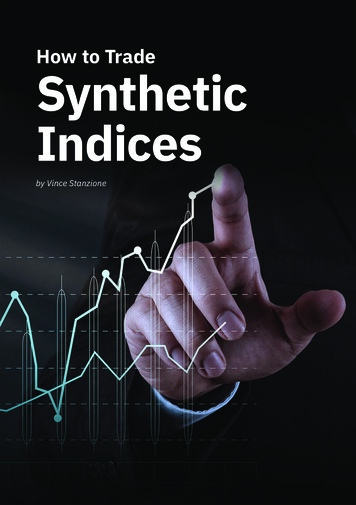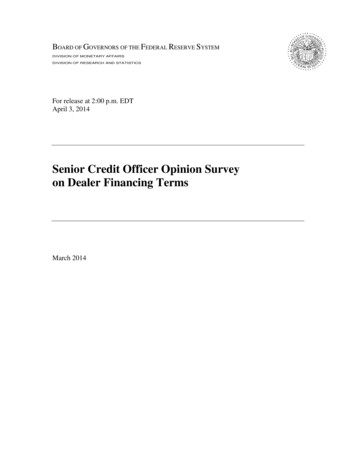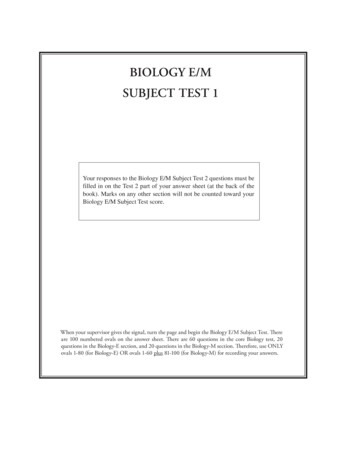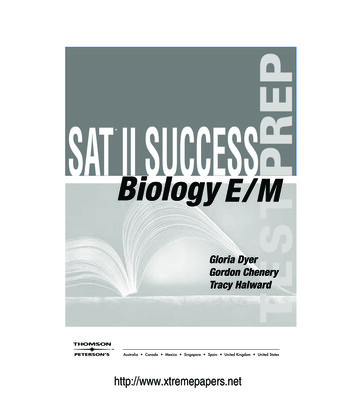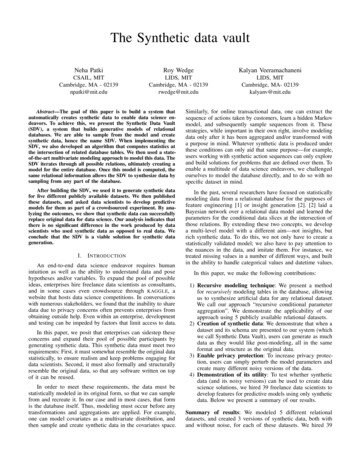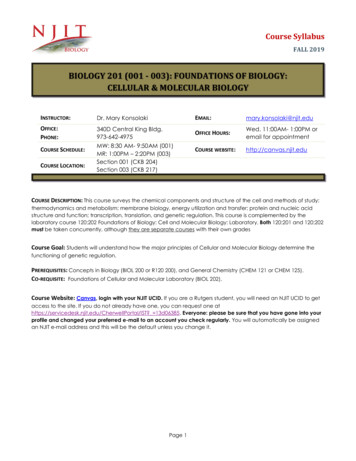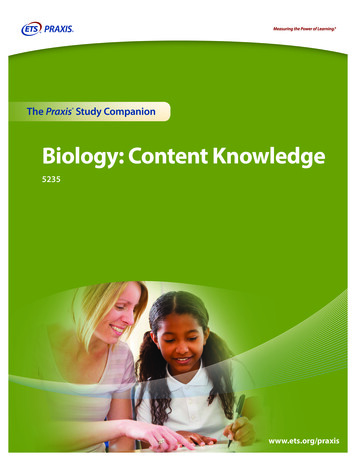
Transcription
U N I T E D N AT I O N S C O N F E R E N C E O N T R A D E A N D D E V E L O P M E N TSYNTHETIC BIOLOGY AND ITSPOTENTIAL IMPLICATIONSFOR BIOTRADE AND ACCESS ANDBENEFIT-SHARING
2019, United Nations Conference on Trade and Development.All rights reserved.The trends, figures and views expressed in this publication are those of UNCTAD and do not necessarily representthe views of its member States. The designations employed and the presentation of material on any map in thiswork do not imply the expression of any opinion whatsoever on the part of the United Nations concerning thelegal status of any country, territory, city or area or of its authorities, or concerning the delimitation of its frontiersor boundaries.This study can be freely cited provided appropriate acknowledgment is given to UNCTAD.For further information on UNCTAD’s BioTrade Initiative please consult the following website: http://www.unctad.org/biotrade or contact us at: biotrade@unctad.orgThis publication has not been formally edited.UNCTAD/DITC/TED/INF/2019/12
AND ITS POTENTIAL IMPLICATIONS FOR BIOTRADE AND ACCESS AND viations.vEXECUTIVE SUMMARY. viSECTION 1: INTRODUCTION TO BIOTRADE, SYNTHETIC BIOLOGY AND SYNTHETIZATION. 11. BioTrade. 12. Defining synthetic biology. 23. Synthetic biology approaches. 4Genome engineering. 4Metabolic engineering. 5Implications for BioTrade and ABS. 54. The difference between chemical synthesis and biosynthesis . 6Chemical synthesis. 6Biosynthesis. 6Implications for BioTrade and ABS. 7SECTION 2: CASE STUDIES ON NATURAL PRODUCTS, SYNTHESIZATION AND SYNTHETICBIOLOGY. 81. Flavours and fragrances. 8Vanilla. 8Patchouli. 10Orange. 10Stevia . 102. Pharma and phytopharmaceuticals. 12Artemisinin. 12SECTION 3: LAW AND POLICY ISSUES AT THE INTERFACE OF BIOTRADE AND SYNTHETICBIOLOGY. 141. Food labelling. 14United States. 14European Union. 142. Cosmetic products. 15United States. 15European Union. 153. Voluntary certification. 16Non-GMO certification. 16COSMOS. 16NATRUE. 16SECTION 4: CONCLUSIONS ON IMPLICATIONS OF SYNTHETIC BIOLOGY FOR BIOTRADEAND ABS. 181. General conclusions on possible implications of SynBio for BioTrade. 182. Potential implications of SynBio for ABS. 203. Recommendations on the way forward for BioTrade. 20
SYNTHETIC BIOLOGYivANNEX I:DEFINITIONS OF SYNTHETIC BIOLOGY. 24ANNEX II: SELECTED SYNTHETIC BIOLOGY TOOLS AND TECHNIQUES. 251.2.3.4.BioBrick engineering. 25Bioinformatics. 25Design tools. 26Construction tools. 27Genome-editing technologies . 27Gene synthesis technologies. 27Biofoundries. 27GLOSSARY. 28Notes. 30FiguresFigure 1:Figure 2:Figure 3:Figure 4:Figure 5:Figure 6:SynBio ingredient production with genetically modified yeast. 6Examples of different methods of obtaining vanillin. 9Dried leaf artemisia phytomedicine. 12GenoCAD online platform. 26Traditional vs Twist Bioscience DNA synthesis platform. 27The architecture of a typical biofoundry. 28TablesTable 1:Table 2:BioTrade sectors prioritized by countries and partners. 2Examples of SynBio products that could replace naturally sourced biological resources. 13AcknowledgementsThis study was prepared by Mr. Frederic Perron-Welch, Access and Benefit-Sharing (ABS) Consultant for theBioTrade Initiative of the Trade, Environment, Climate Change and Sustainable Development Branch of UNCTAD.The study has greatly benefited from peer reviews and substantive inputs by: Ms. Lorena Jaramillo, EconomicAffairs Officer, and Mr. David Vivas Eugui, Legal Officer, of the Trade, Environment, Climate Change and SustainableDevelopment Branch (TED) of UNCTAD; Ms. Anne Schick (Swiss State Secretariat for Economic Affairs SECO);Molly Bond (Bristol University); Dr. Marco D’Alessandro (Swiss Federal Institute of Intellectual Property (IPI)); Dr.Hartmut Meyer, (ABS Capacity Development Initiative); Ms. Maria Julia Oliva (Union for Ethical BioTrade (UEBT));Dr. Balakrishna Pisupati (Forum for Law, Environment, Development and Governance (FLEDGE)); and Mr. AndrewWilson (Helvetas Swiss Intercooperation). Desktop formatting was done by Mr. Rafe Dent of UNCTAD.UNCTAD gratefully acknowledges the support of SECO in the development of this study under the GlobalBioTrade Programme: Linking trade, biodiversity and sustainable development.2 October 2019
AND ITS POTENTIAL IMPLICATIONS FOR BIOTRADE AND ACCESS AND ASTBPABT AEGGenTDurchfGEMBL-EBIFAOFDAFCIGates NCBINGSNIHOECDOnline ForumOpen IPOZFNAccess and benefit-sharingAd Hoc Technical Expert Group on Synthetic BiologyBioBricks FoundationComputer-Aided Design software environments for biologyBasic Local Alignment Search ToolBioBrick Public AgreementBioTrade Principles & CriteriaComputer-Aided DesignCRISPR-Associated Protein 9Convention on Biological DiversityConvention on International Trade in Endangered Species of Wild Fauna and FloraConference of the PartiesCOSMetic Organic StandardClustered regularly interspaced short palindromic repeatsDNA Data Bank of JapanDeoxyribonucleic acidDigital sequence informationEuropean Commission Scientific CommitteesEuropean Food Safety AuthorityGerman Genetic Engineering Implementation ActEuropean Bioinformatics Institute at the European Molecular Biology LaboratoryUnited Nations Food and Agriculture OrganizationUnited States Food and Drug AdministrationFrance Chirurgie Instrumentation S.A.S.Bill & Melinda Gates FoundationGenetically modified organismsGenerally recognized as safeInternational Genetically Engineered Machine CompetitionInternational Flavors & FragrancesInternational Nucleotide Sequence DatabaseInternational Union for Conservation of NatureJoint FAO/WHO Expert Committee on Food AdditivesLiving modified organismsMultiplex Automated Genome EngineeringMutually agreed termsNational Center for Biotechnology InformationNext generation sequencingNational Institutes of HealthOrganisation for Economic Co-operation and DevelopmentOpen-ended Online Forum on Synthetic BiologyOpen Material Transfer AgreementPrior informed consentSubsidiary Body on Scientific, Technical and Technological AdviceEuropean Union Scientific Committee on Consumer SafetyEuropean Union Scientific Committee on Emerging and Newly Identified Health RisksEuropean Union Scientific Committee on Health and Environmental RisksSustainable Development GoalsSemisynthetic artemisininSynthetic biologyTranscription Activator-Like Effector NucleaseWorld Health OrganisationWorld Intellectual Property OrganisationZinc-finger nucleasev
SYNTHETIC BIOLOGYviEXECUTIVE SUMMARYSynthetic biology was identified as an emerging issue meriting further research at the first meeting of the UNCTADBioTrade Initiative Stakeholder Steering Committee meeting in 2018. This first study on the implications of syntheticbiology for BioTrade was developed based on this request in order to provide guidance and further comprehensionof the topic, especially its implications for BioTrade. BioTrade partners are expected to further support this line ofwork to enhance knowledge and provide practical experiences that enrich the findings in this study.Although there is no universally agreed upon definition of the term ‘synthetic biology’, the 13th Conference of theParties (COP) to the Convention on Biological Diversity acknowledged the following definition as a useful startingpoint for continued discussions: “a further development and new dimension of modern biotechnology thatcombines science, technology and engineering to facilitate and accelerate the understanding, design, redesign,manufacture and/or modification of genetic materials, living organisms and biological systems.” As such, it fallswithin the scope of the Convention and its Protocols on biosafety and access and benefit-sharing (ABS).Through this study, particularly the case studies, UNCTAD aims to show the potential implications of syntheticbiology for BioTrade and ABS. From the research carried out, it appears that synthetic biology will not havedirect impacts on all BioTrade sectors, as existing technologies mainly target specific market sectors such as thecosmetics sector, food and fragrances sector, and pharma/phytopharmaceutical sector. The most foreseeableconsequence for BioTrade is the displacement of naturally sourced ingredients with ingredients produced throughthe use of synthetic biology. However, displacement in the BioTrade sector may be limited, as consumerspurchasing products with BioTrade ingredients are likely looking to purchase products produced in line witheconomic, social and environmental sustainability criteria and are less likely to be influenced by cost savingsresulting from the use of synthetic biology ingredients. This trend is especially strong with younger consumers.Many of the implications of synthetic biology for BioTrade remain prospective because most synthetic biologycompanies are not yet producing economically competitive products. Given this, it is an opportune time forBioTrade actors to take a proactive approach to this matter. Based on the analysis conducted in the study, severalrecommendations for BioTrade can be made. These recommendations offer different possible approachesto addressing synthetic biology in the revised BioTrade Principles and Criteria (BT P&C), and addressing itsimplications for the sustainable use of biodiversity more broadly.Recommendations:1. Provider countries may want to consider conducting socioeconomic impact assessments for nationallyimportant value chains when a synthetic biology alternative appears on the market in order to determine itspotential impact on jobs and livelihoods.2. Where there is a significant risk to jobs and livelihoods, it may be appropriate for provider countries to assistproducers to transition to different BioTrade value chains to prevent the impact on livelihoods and biodiversitythat would result from a shift away from the existing value chain.3. Consider the need and potential implications of defining “natural product” or “goods and services derivedfrom native biodiversity” in the context of BioTrade. This would be a challenging undertaking and it may bepreferable to leave this to national decision makers and standard-setting bodies.4. Consider addressing how the BioTrade Principles and Criteria address specific types of technologies orproducts falling under the broad scope of synthetic biology. This may include the question of whether a broadapproach is preferable, or whether a case-by-case approach based on sustainability criteria is appropriate.5. Consider whether a case-by-case approach to the use of products fabricated with genetically modified/synthetic biology organisms in BioTrade products is appropriate where they are demonstrably moresustainable than their naturally derived counterparts (e.g. where there is a trade ban under CITES, listed onthe International Union for Conservation of Nature (IUCN) Red List).6. If a case-by-case approach is adopted, consider the development of a traceability mechanism for ingredientsthat are derived from CITES-listed species to prove that they have been fabricated using SynBio processesand not directly from these species.
AND ITS POTENTIAL IMPLICATIONS FOR BIOTRADE AND ACCESS AND BENEFIT-SHARINGSection 1:INTRODUCTION TOBIOTRADE, SYNTHETICBIOLOGY ANDSYNTHETIZATIONThis emerging issues study on the implications ofsynthetic biology (SynBio) for BioTrade was developedat the request of BioTrade Initiative partners, whorequested further guidance and understanding ofthe topic of SynBio and its potential implicationsfor BioTrade. This section addresses the conceptof BioTrade, the field of SynBio, and the differencesbetween chemical synthesis and biosynthesis.1. BioTradeBioTrade involves the collection, production,transformation and commercialization of goods andservices derived from native biodiversity (speciesand ecosystems) under environmental, social andeconomic sustainability criteria—the BioTradePrinciples and Criteria (BT P&C). The underlyingpremise of BioTrade is that biodiversity basedproducts — if sourced and elaborated with respect for1equity, fairness and sustainability principles — can alsoprovide a strong basis for local livelihoods, respect fortraditional practices and values, and the conservationand sustainable use of biodiversity. A distinction mustbe drawn between BioTrade that takes place in linewith the BT P&C, and the broader trade in biodiversitybased products, as not all commercial use of biologicalresources is sustainable.1BioTrade is being implemented in sectors such aspersonal care, pharmaceutical (phytopharma); food;fashion; ornamental flora and fauna; handicrafts;textiles and natural fibres; sustainable tourism; andforestry-based carbon credit activities.2 Specificexamples of BioTrade products are provided in theTable 1 (page 2).Although not relevant to all BioTrade sectors, syntheticbiology (SynBio) products could have an impacton BioTrade value chains in the following sectors:personal care; pharmaceutical (phytopharma); food;fashion; and textiles/natural fibres. Case studieson existing and emerging SynBio products in thecosmetics and flavourings and fragrance sectors willbe presented in this report in order to demonstratethe potential for impacts on BioTrade value chains, asthey are the most developed and have the greatestpotential impact.Box 1: Sample BioTrade caseIn 2009, Weleda, a Swiss-based company producing natural and organic beauty products and anthroposophicmedicines, and a [Union for Ethical BioTrade] member, launched a project for the organic and sustainablecultivation of sandalwood in Sri Lanka. Sandalwood is used as an essential oil and fragrance for a range ofWeleda products For Weleda, it is fundamental that the sandalwood oil used not only comes from organicand sustainable sources, but also contributes to increasing the number of sandalwood trees in Sri Lanka andto the livelihoods of local communities.In this context, Weleda formed a partnership with a local family-owned company. Together, they found anold, abandoned tea plantation in the highlands of Sri Lanka. There, next to 100-year-old tea bushes, grewalmost 1000 sandalwood trees, including young saplings. The trees had spread naturally thanks to birdscarrying seeds and had thrived on the steep terrain protected by the wide root systems of the tea bushes.With the support of Weleda, the company invested in the land and techniques for organic and sustainableharvesting of sandalwood In line with the Ethical BioTrade Standard – based on BT P&C – the Weleda sandalwood project alsohas a strong social component. Weleda signed an agreement committing to the project and to sourcingexclusively from this company for a number of years. It has also supported the creation of a plant nurseryand a training and education centre for the collectors. This centre focuses not only on sandalwood, butalso on the cultivation of vegetables, tea and cinnamon trees. This is to ensure that a variety of crops iscultivated – key to local food security and to diversifying local incomes. For example, the local company nowindependently harvests and commercializes other crops, with an organic certification.Source: 20 Years of BioTrade: Connecting People, the Planet and Markets, pp. 24-5.
SYNTHETIC BIOLOGY2Table 1: BioTrade sectors prioritized by countries and partnersSectorType of productPersonal careEssential oils, natural dyes, soaps, cream and butters, cosmetics, etc.Pharmaceutical (phytopharma) Extracts, capsules and infusions from medicinal plants, etcFoodFruit pulps, juices, jams, biscuits, sauces, spices, nuts, tubers, snacks, food supplements, meat fromcaiman and fish, etc.FashionSkin and belts, bags from Caiman yacare, etc.Ornamental flora and faunaHeliconias, orchids, butterflies, etcHandicraftsJewellery, decorative objects based on native species, garments, etcTextiles and natural fibresFurniture and decorative objects based on natural fibres, bags, shoes, etc.Sustainable tourismEcotourism, nature-based tourism, community-based tourism, etc.Forestry-based carbon credit Reducing Emissions from Deforestation and Forest Degradation, conservation, sustainableactivitiesmanagement of forests and enhancement of forest carbon stocks (REDD ), greenhouse gas (GHG)emissions mitigation strategies for specific value chains, etc.Source: L Jaramillo & B Onguglo, “BioTrade — harmonizing trade, biodiversity and livelihoods” in 20 Years of BioTrade: ConnectingPeople, the Planet and Markets, United Nations Doc. UNCTAD/DITC/TED/2016/4, 3.2. Defining synthetic biologySynBio is a rapidly developing field which emergedfrom developments in genetic engineering in recentdecades.3 It builds on advances in molecular biology,genetic engineering and microbiology,4 while alsomoving beyond these fields through the embraceof “techniques and ideas from biology, engineering,chemistry and materials sciences.”5 SynBio uses allavailable genetic engineering technologies, but aimsat a faster and easier process.6 As such, it is bestunderstood as “an umbrella term that gathers aset of activities that ranges from the basic sciences toinnovative technology, rather than as a new scientificparadigm.”7 It is “a toolbox, not an end in itself.”8 Theactivities taking place in the field of SynBio are not sodistinct from earlier technologies as to fall outside thebroad definition of biotechnology provided for in theConvention on Biological Diversity (CBD),9 namely: “anytechnological application that uses biological systems,living organisms, or derivatives thereof, to make ormodify products or processes for specific use.”10Yet, there is no commonly agreed upon definition forSynBio. Annex I provides a short summary of differentdefinitions provided by international expert groups,and the commonalities between these definitions.Because of the rapid and ongoing evolution of the fieldof SynBio, it is not possible for this study to establisha definitive definition of the term, or every potentialimplication for BioTrade. Rather, this study will becarried out using the horizon scan methodology,defined by the OECD as “a technique for detectingearly signs of potentially important developmentsthrough a systematic examination of potential threatsand opportunities, with emphasis on new technologyand its effects on the issue at hand.”11In the past decade, SynBio has become “a key partof 21st century bioscience and biotechnology.”12Advances in reading DNA (sequencing) and writingDNA (synthesis) have “have led to the developmentof ground-breaking technologies for the design,assembly, and manipulation of DNA encoded genes,materials, circuits, and metabolic pathways, which areallowing for an ever greater manipulation of biologicalsystems and even entire organisms.”13 Next generationsequencing (NGS) technologies and DNA synthesistechnologies “form the two foundational technologiesdriving synthetic biology efforts and will eventually instillthe predictability and reliability to engineered biologicalsystems that chemical engineering has brought tochemical systems.”14 Due to NGS technologies, therehas been a boom in DNA sequence repositories, andassociated improvements in bioinformatics techniquesand software.15 Technological developments havesubsequently “have made it possible to ‘mine’ geneticdata from a wide variety of organisms and then tosynthesize new genetic constructs that modify thefunction of living organisms.”16 The growing number ofdatabases containing “digital sequence information”17(DSI) form “an enormous potential catalogue ofnatural ‘parts’—functional units of DNA—from whichhigh-value chemical pathways can be discovered orcreated.”18 The widespread availability of DSI is ofgreat significance for SynBio, as “[t]he rise of DNA
AND ITS POTENTIAL IMPLICATIONS FOR BIOTRADE AND ACCESS AND BENEFIT-SHARINGsynthesis has moved biology toward an informationscience where the DNA can be reconstructed from thesequence information alone, thus eliminating the needfor physical transfer and enabling the direct accessto biological functions encoded in the sequencedatabases.”19 An overview of these developments canbe found in Annex II.Since 2012, the Conference of the Parties (COP) tothe CBD has been looking into SynBio in the contextof its work on new and emerging issues relating tothe conservation and sustainable use of biodiversity.20This examination is based on “the need to considerthe potential positive and negative impacts ofcomponents, organisms and products resultingfrom [SynBio] techniques on the conservation andsustainable use of biodiversity” in application of theprecautionary approach.21 Parties at COP 11 initiatedthis enquiry by requesting the Secretariat to compile“relevant information on components, organisms andproducts resulting from synthetic biology techniquesthat may have impacts on the conservation andsustainable use of biological diversity and associatedsocial, economic and cultural considerations”22 in orderto assess whether it qualifies as a new and emergingissue. This information would then be compiled andsynthesized by the Secretariat,23 possible gaps andoverlaps with the applicable provisions of the CBD,its Protocols and other relevant agreements related tocomponents, organisms and products resulting fromsynthetic biology techniques would be considered,24and a synthesis of this information made availablefor peer review and subsequent consideration by ameeting of the Subsidiary Body on Scientific, Technicaland Technological Advice (SBSTTA) prior to COP 12.This would include an analysis of how the criteria setout for new and emerging issues apply to syntheticbiology. These criteria25 are as follows:a. Relevance of the issue to the implementationof the objectives of the Convention and itsexisting programmes of work;b. New evidence of unexpected and significantimpacts on biodiversity;c. Urgency of addressing the issue/imminence ofthe risk caused by the issue to the effectiveimplementation of the Convention as well asthe magnitude of actual and potential impacton biodiversity;d. Actual geographic coverage and potentialspread, including rate of spread, of theidentified issue relating to the conservationand sustainable use of biodiversity;3Synthetic biology“is a further development and new dimension ofmodern biotechnology that combines science,technology and engineering to facilitate andaccelerate the understanding, design, redesign,manufacture and/or modification of geneticmaterials, living organisms and biologicalsystems”e. Evidence of the absence or limited availabilityof tools to limit or mitigate the negative impactsof the identified issue on the conservation andsustainable use of biodiversity;f. Magnitude of actual and potential impact ofthe identified issue on human well-being;g. Magnitude of actual and potential impactof the identified issue on productive sectorsand economic well-being as related tothe conservation and sustainable use ofiodiversity.”26The SBSTTA considered the proposal at COP 11to make SynBio a new and emerging issue, butconcluded that although SynBio is of relevance to theCBD, there was insufficient information available tofinalize an analysis using the above criteria to decidewhether or not it is a new and emerging issue.27 Thiswas affirmed by COP 12, which established an Ad HocTechnical Expert Group on Synthetic Biology (AHTEGSB) to carry out further research and report back to ameeting of the SBSTTA prior to COP 13.28 One of thetasks assigned to the AHTEG-SB was to work on anoperational definition for SynBio,29 which it issued in2015, stating that SynBio “is a further developmentand new dimension of modern biotechnology thatcombines science, technology and engineering tofacilitate and accelerate the understanding, design,redesign, manufacture and/or modification of geneticmaterials, living organisms and biological systems.”30COP 13 acknowledged the outcome of the workof the AHTEG-SB on an operational definition, andconsidered it useful as a starting point for facilitatingsci
Parties (COP) to the Convention on Biological Diversity acknowledged the following definition as a useful starting point for continued discussions: “a further development and new dimension of modern biotechnology that combines science, technology and engineering to facil

